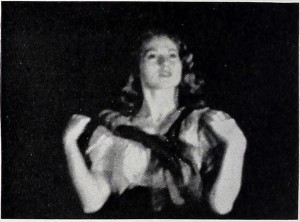
"In The Alpine Vixen, a dramatic story based on folklore legend, Anchor 0. Jensen has raised 8mm. color filming to a level that movie makers in any width would do well to emulate. Particularly in the double exposed sequence of the Titian haired girl in a cave of crystals does he prove his skill with the camera. Mr. Jensen also achieves unusually pleasant outdoor lighting, both in close shots and more distant scenes. The film is accompanied by a narrative, to clarify the pictured story, interspersed with a folk tune played on an accordion, all of which is recorded on a sixteen inch disc. One might have hoped for more somber music to match the menacing mood of the early part of the film, but the accordion tune is in keeping with the climactic scenes of the festive villagers. Infelicities of modern accouterments which would have marred the spirit of the legendary tale have been judiciously avoided." Movie Makers, Dec. 1945, 494.
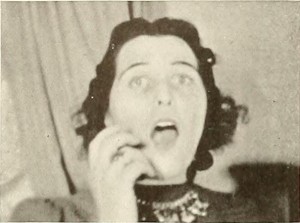
"When Ernest Kremer wanted to make a film which would include his family and, at the same time, be entertaining to outsiders, he devised An Anaesthetic Fantasy, an ingenious tale of the nightmare of a dental patient under laughing gas. The patient imagines that he returns home, and there things begin to happen that confound him and the audience, too. Clever trick work, dissolves and stop motion are used to create this section of the film. Mr. Kremer has proved that the 8mm. worker need not bow to his 16mm. brothers when it comes to producing cine illusions. The film was presented with a delightfully appropriate selection of musical records played on a dual turntable outfit." Movie Makers, Dec. 1940, 601-602.
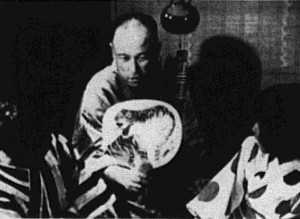
"A delightful bit of drama filmed by Kazuo Nakamura again illustrates that one does not have to travel far from his home to film a picture. This was filmed in Japan and one may assume that the maker had the cooperation of a local dramatic group. Mr. Nakamura has shown his skill and accomplishment in the finished product. It is a story within a story. The father tells his young son and daughter about the legend of the arrow which comes from nowhere to fall upon a roof. That home must sacrifice a daughter to some unknown person which in the story is a terrible old tiger. The animal, in the disguise of a man meets his fate at the hands of a god who disappears as mysteriously as he had appeared, while the villagers dance and celebrate their freedom. The children are now fast asleep. Although their native language is heard throughout, the story is easily followed. The costuming and acting are superb in their simplicity." PSA Journal, Nov. 1957, 32.
"The Beasts Shall Inherit the Earth for the excellently made props in the form of creatures that appear in the film from time to time to drive out the populace and take over for themselves. Many times these props look genuinely alive" PSA Journal, Sept. 1966, 36.
"Delmer J. Frazier, ACL, of Oakland, Calif., is a man who can see the fine possibilities for plot ideas sticking out all about him in the current popular magazines. In his delightful film, Black Magic, he used an advertisement, but stories and funny papers are pretty fertile too. His story opened with the young lad of the house immersed in the mystic joys offered by a pancake flour company. ''Send Ten Wrappers and Get the Magic Wand!" He did, the wand arrived and the fun began. Fun, until his chum said the wrong magic words and started to disappear — wand and all. Only heroic measures on the part of our hero (and the cameraman) saved the day." Movie Makers, April 1935, 167.
"This was a well thought picture, but lacked a bit in photography to stack up with the prize winners." American Cinematographer, Feb. 1936, 73.
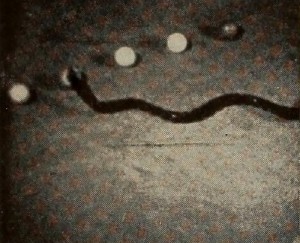
"Candy Capers is a gay little dance fantasy in animation, using lollypops, wafers and other familiar childhood sweets. It is gay, that is, until the entrance of the villain— a long black sinuous licorice snake. The wafers shiver in horror as one of them is captured by the intruder. Then they organize their attack and rout the enemy. Roy Fulmer jr. has achieved smooth animation of his puppets and accompanies them with a pleasant musical score. The result is a bit of confection that is a delight to the eye and ear." Movie Makers, Dec. 1953, 334.
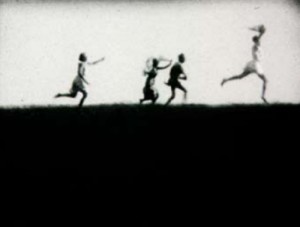
"Combines ancestral memory with reincarnation when the main character falls asleep, sees nymphs dancing in the same landscape hundreds of years in the past, and confronts his previous incarnation herding sheep and wearing fur." UC Berkeley Library.
"Christmas Nuts, presented with a sound on film recording on a separate 16mm. film, produced by Paul Braun and Howard Goodman, is not only an interior color picture of exceptional beauty and impeccable technical quality but is also one of the best puppet films thus far created. With a camera technique paralleling that of the latest theatrical, animated talkie cartoons, the story of a wolf "hijacking" Santa Claus and the consequent near calamity for the two squirrels is unfolded in a completely cinematic fashion. The camera moves freely from medium shot to closeup, the mechanics of the sets are not obstrusive and the puppets move with agility and grace. The sets, which were designed and constructed with great care, are very handsome and exquisitely finished so that no imperfections are revealed in the enlarged picture of them on the screen. The sets, in combination with the colored lights used in part to illuminate them, embody the producers' theory of "created color." That is, no attempt is made to simulate nature, but rather to produce pleasing, vivid color combinations, as in the illustrations of a child's story book. A cleverly compiled dialog, song and music accompaniment has been synchronized with the picture, although recorded, at present, on a separate film." Movie Makers, Dec. 1935, 534.
"a sogg. breve" short fiction
"Parabola, e La città sogna, regia di Guido Pallaro. Questi due film di Guido Pallaro hanno sopratutto un pregio: la buona volontà che dimostra l'autore, giovanissimo, di raggiungere qualche risultato adoperando tutti i mezzi possibili; passato questo periodo di esuberanza non esente da ingenuità stilistiche ed anche da arditezze ingiustificate, Pallaro potrà fornire opere di maggior impegno e più solida struttura. Nella Citta sogna che comprende i sogni di diversi individui il sogno del bambino ha qualche passaggio notevole, e in Parabola si avverte la ricerca di raggiungere nuovi motivi anche se i risultati non appaiono sempre realizzati con equilibrio."
"Parabola, and The City Dreams (La città sogna), directed by Guido Pallaro. These two films of Guido Pallaro have above all one merit: the good will that demonstrates their author, who is very young, to reach here some results using all possible means; having passed this period of exuberance not exempt from stylistic ingenuousness and also from unjustified daring, Pallaro has the capacity to provide works of greater commitment and more solid structure. In The City Dreams, which includes the dreams of various individuals, the dream of the child has some notable passages, and in Parabola one senses the search for new motifs even if the results do not always appear to be realized with balance."
— Il Ventuno 26 (Review of the G.U.F. of Venice) March 1935
"'Creatures of the Past' was highly enjoyed. It is the work of C. E. Welsh and C. B. O'Donovan of Pittsburgh. They took as their models a display made by local and New York department stores. The manner in which they photographed led the viewer back centuries to the time when the prehistoric mammoth was on this earth. Honorable mention was accorded these cinematographers for their work." American Cinematographer, Feb. 1936, 73.
Total Pages: 5